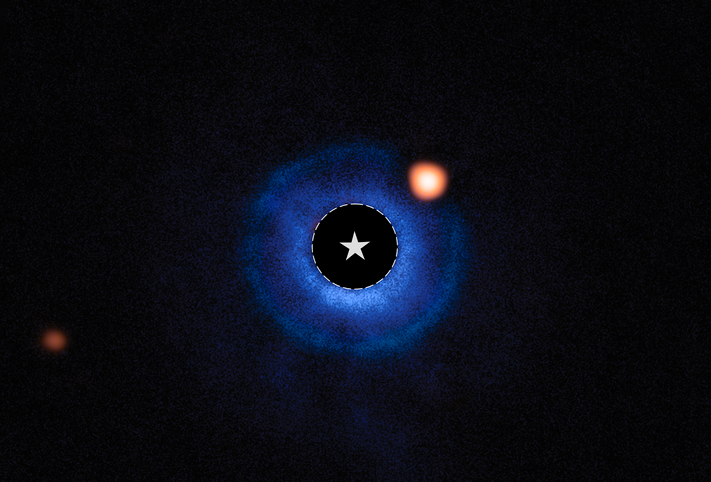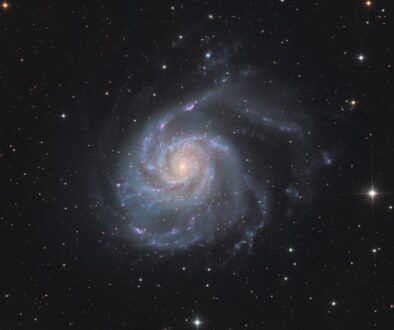Likely Saturn-Mass Planet Imaged by NASA Webb Is Lightest Ever Seen
Astronomers using NASA’s James Webb Space Telescope have captured compelling evidence of a planet with a mass similar to Saturn orbiting the young nearby star TWA 7. In the above image combining ground-based data from ESO’s Very Large Telescope (VLT) and data from Webb’s MIRI (Mid-Infrared Instrument), light from the star TWA 7 has been subtracted. The location of the star is marked with a circle and a star symbol at the center of the image. The blue color represents data from the VLT’s SPHERE instrument, which showcases the location of the disk surrounding the host star. MIRI data is shown in orange. The bright orange spot to the upper right of the star is the source identified as TWA 7 b, within the debris disk. The more distant orange spot visible in the left of the image is an unrelated background star. Credits: NASA, ESA, CSA, Anne-Marie Lagrange (CNRS, UGA), Mahdi Zamani (ESA/Webb)
Astronomers using NASA’s James Webb Space Telescope have captured compelling evidence of a planet with a mass similar to Saturn orbiting the young nearby star TWA 7. If confirmed, this would represent Webb’s first direct image discovery of a planet, and the lightest planet ever seen with this technique outside the solar system.
The international team detected a faint infrared source in the disk of debris surrounding TWA 7 using Webb’s MIRI (Mid-Infrared Instrument). The distance between the source and TWA 7 is estimated to be about 50 times the distance of the Earth from the Sun. This matches the expected position of a planet that would explain key features seen in the debris disk. The results published Wednesday, June 25 in the journal Nature.
Using MIRI’s coronagraph, the researchers carefully suppressed the bright glare of the host star to reveal faint nearby objects. This technique, called high-contrast imaging, enables astronomers to directly detect planets that would otherwise be lost in the overwhelming light from their host star. After subtracting residual starlight using advanced image processing, a faint infrared source was revealed near TWA 7. The team ruled out an object in our solar system that happened to be in the same part of the sky as the source. While there is a very small chance that it is a background galaxy, the evidence strongly points to the source being a previously undiscovered planet.
The source is located in a gap in one of three dust rings that were discovered around TWA 7 by previous ground-based observations. The object’s brightness, color, distance from the star, and position within the ring are consistent with theoretical predictions for a young, cold, Saturn-mass planet that is expected to be sculpting the surrounding debris disk.
“Our observations reveal a strong candidate for a planet shaping the structure of the TWA 7 debris disk, and its position is exactly where we expected to find a planet of this mass,” said Anne-Marie Lagrange, CNRS researcher at the Observatoire de Paris-PSL and Université Grenoble Alpes in France, lead author of the paper.
(Source: webbtelescope.org)




